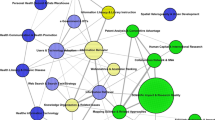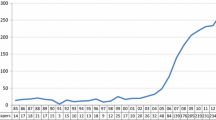Abstract
This study aims to reveal the intellectual structure of Library and Information Science (LIS) in China during the period 2008–2012 utilizing co-word analysis. The status and trends of LIS in China are achieved by measuring the correlation coefficient of selected keywords extracted from relevant journals in the Chinese Journal Full-Text Database. In co-word analysis, multivariate statistical analysis and social network analysis are applied to obtain 13 clusters of keywords, a two-dimensional map, centrality and density of clusters, a strategic diagram and a relation network. Based on these results, the following conclusions can be drawn: (i) LIS in China has some established and well-developed research topics; (ii) a few emerging topics have a great potential for development; and (iii), the research topics in this LIS field are largely decentralized as a whole, where there are many marginal and immature topics.



Similar content being viewed by others
References
Callon, M., Courtial, J. P., & Laville, F. (1991). Co-word analysis as a tool for describing the network of interactions between basic and technological research: The case of polymer chemistry. Scientometrics, 22(1), 155–205.
Callon, M., Courtial, J. P., Turner, W. A., & Bauin, S. (1983). From translations to problematic networks: An introduction to co-word analysis. Social Science Information, 22(2), 191–235.
Cambrosio, A., Limoges, C., Courtial, J. P., & Laville, F. (1993). Historical scientometrics? Mapping over 70 years of biological safety research with co-word analysis. Scientometrics, 27(2), 119–143.
Coulter, N., Monarch, I., & Konda, S. (1998). Software engineering as seen through its research literature: A study in co-word analysis. Journal of the American Society for Information Science, 49(13), 1206–1223.
Ding, X. (2010). Research on the book intelligent recommendation system based on data mining. Information Studies: Theory & Application (in China), 33(5), 107–110.
Ding, Y., Chowdhury, G., & Foo, S. (2001). Bibliometric cartography of information retrieval research by using co-word analysis. Information Processing and Management, 37(6), 817–842.
Law, J., Bauin, S., Courtial, J. P., & Whittaker, J. (1988). Policy and the mapping of scientific change: A co-word analysis of research into environmental acidification. Scientometrics, 14(3), 251–264.
Lee, W. H. (2008). How to identify emerging research fields using scientometrics: An example in the field of information security. Scientometrics, 76(3), 503–525.
Li, N. (2011). Analysis on research hotspots and trends of library and information sciences from 2004 to 2009 in China. Information Science (in China), 29(4), 583–587.
Liu, G. Y., Hu, J. M., & Wang, H. L. (2012). A co-word analysis of digital library field in China. Scientometrics, 91(1), 203–217.
Qiu, J. P., Yang, S. L., Wang, M. Z., & Liu, M. (2009). Content analysis on the research papers of information science in China from 1978 to 2008. Document, Information and Knowledge (in China), 3, 5–17.
Small, H. (1973). Co-citation in the scientific literature: A new measure of the relationship between two documents. Journal of the American Society for Information Science, 24(4), 265–269.
Small, H., & Griffith, B. C. (1974). The structure of scientific literatures I: Identifying and graphing specialties. Science Studies, 4(1), 17–40.
Sun, H. S., & Zhang, S. G. (2011). The social network analysis on cross-citation network of core authors in information science. Journal of Intelligence (in China), 30(3), 78–83.
Wang, H. (2011). Analysis of the hotspots of Chinese LIS for ten decade by co-word analysis. Journal of Intelligence (in China), 30(3), 59–64.
Wang, L. Y., Zhang, Z. Q., & Wei, J. Z. (2011). A study on foreign research subjects of library and information science based on the co-word analysis during the last ten years. Journal of intelligence (in China), 30(3), 50–58.
Wu, S. Z. (2010). Analysis of hot spots in field of data mining and knowledge discovery. Journal of Intelligence (in China), 29(7), 18–24.
Xiao, M., Li, G. J., & Yang, N. (2009). The hot topics of information science between 1998 ~ 2007 based on word frequency analysis. Journal of Intelligence (in China), 28(8), 21–25.
Yang, A.Q. (2012). Visualization of the current research status of LIS in China. The Master Degree Dissertation of Qufu Normal University (in China).
Yang, Y. (2012b). Research hotspots of LIS in China from 2006 to 2010. Journal of Library Science (in China), 5, 134–136.
Zhang, M., Ma, J., & Shi, X. (2010). Research on field ontology applications in information retrieval. Journal of the China Society for Scientific and Technical Information (in China), 29(2), 215–222.
Zhang, H. C., Wu, W. H., & Wang, Q. P. (2011). Analysis on the current hot problems of library and information science research by multi-angular. Journal of Modern Information (in China), 31(3), 51–54.
Zheng, J. S. (2010). Analysis on research hot spot on library and information science of China in 2009. Library Work and Study (in China), 3, 14–18.
Acknowledgments
This study is supported by the Project of High-level International Journals Paper for Cultivation of Wuhan University (2012GSP070), National Natural Science Foundation of China (71273197), MOE (Ministry of Education in China) Project of Humanities and Social Sciences (13YJC870008), and the Wuhan University Academic Development Plan Program of Scholars after 70s “Network User Behavior Research”.
Author information
Authors and Affiliations
Corresponding author
Rights and permissions
About this article
Cite this article
Hu, CP., Hu, JM., Deng, SL. et al. A co-word analysis of library and information science in China. Scientometrics 97, 369–382 (2013). https://doi.org/10.1007/s11192-013-1076-7
Received:
Published:
Issue Date:
DOI: https://doi.org/10.1007/s11192-013-1076-7




